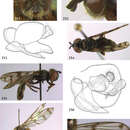Paramixogaster: Brief Summary
provided by wikipedia EN
Paramixogaster is a genus of hoverflies, with 25 known species. Paramixogaster has an appendix on vein R4+5 that is absent in Mixogaster.
- license
- cc-by-sa-3.0
- copyright
- Wikipedia authors and editors
Description
provided by Zookeys
Body length: 5–13 mm. Slender flies with constricted abdomen and long antennae, usually with black and yellow colour pattern, wasp mimics. Head wider than thorax. Face convex in profile; narrower than to wider than an eye. Lateral oral margins not produced. Vertex flat to strongly swollen. Occiput ventrally narrow, dorsally widened. Antennal fossa about as wide as high. Eye bare. Eye margins in male parallel, not converging at level of frons. Antenna longer than distance between antennal fossa and anterior oral margin. Basoflagellomere usually much longer than scape, except shorter in Paramixogaster illucens (Bezzi) and Paramixogaster luxor Curran (see Discussion); bare. Postpronotum bare. Mesoscutum with transverse suture usually incomplete, except complete in Paramixogaster contractus, Paramixogaster conveniens and Paramixogaster omeanus (see Discussion). Scutellum semicircular; without or with small calcars. Anepisternum convex or sulcate; entirely pilose or partly bare on ventral half. Anepimeron entirely pilose. Katepimeron convex; bare. Wing: vein R4+5 with or without posterior appendix; vein M1 perpendicular to vein R4+5 and vein M; postero-apical corner of cell r4+5 rectangular to somewhat acute, with small appendix; crossvein r-m located within basal 1/4 of cell dm. Abdomen elongate, at least 3 times as long as wide; constricted, with narrowest point at tergite 2 and widest point at tergite 3 or 4. Tergites 3 and 4 fused. Male genitalia: phallus furcate, with furcation point in distal 1/3; epandrium without ventrolateral ridge; surstylus weakly furcate, only in Paramixogaster luxor consisting of three distinct branches.
- license
- cc-by-3.0
- copyright
- Menno Reemer, Gunilla Ståhls
- bibliographic citation
- Reemer M, Ståhls G (2013) Generic revision and species classification of the Microdontinae (Diptera, Syrphidae) ZooKeys 288: 1–213
- author
- Menno Reemer
- author
- Gunilla Ståhls
Distribution
provided by Zookeys
Described species: 26. Afrotropical (5 species), Oriental (12) and Australian region (9). Several additional species, from all three regions, await description.
- license
- cc-by-3.0
- copyright
- Menno Reemer, Gunilla Ståhls
- bibliographic citation
- Reemer M, Ståhls G (2013) Generic revision and species classification of the Microdontinae (Diptera, Syrphidae) ZooKeys 288: 1–213
- author
- Menno Reemer
- author
- Gunilla Ståhls

